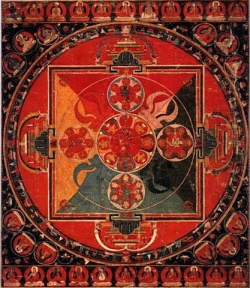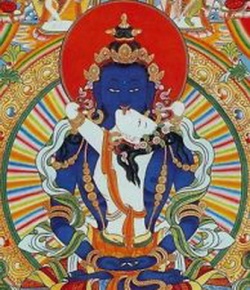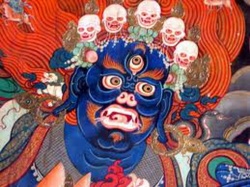Bardo teachings by Chokyi Gocha
Tonight I am teaching about the bardo. A hospice in California asked me to teach a class on the bardo. I read many texts on it when I was younger but did not focus on the meaning. Now I am rereading them and focusing on the meaning. We have lots of consciousneses, the five sense consciousness and the three internal consciousness. All thoughts are like waves on the ocean. When the wind comes, waves arise. In the eye is a support for the eye sense power. The object, sense, and mental faculty come together, causing the eye consciousness to arise. There are beautiful and ugly forms, and forms that give rise to the thought of friend and enemy and thus attachment and hate.
The alaya consciousness stores the seeds of our mental reactions. When the sense consciousness arises, our habitual reaction also arises from the seed in the alaya. Alaya mean all source of consciousness. Chandrakirti says that it is called the all ground because all tendencies are stored there. One year in Death Valley all the flowers bloomed because of the rain. The seeds sat dormant until they got the rain. The alaya is similar. Seeds of the actions of body, speech, and mind are stored there. Hatred is the most powerful emotion. It's like a volcano whose eruption destroys the forest around it. When anger arises, all the good seeds in the alaya are washed away. Alaya is like the ocean and thoughts like the waves.
When alaya is eliminated, what is left is buddha nature or dharmadhatu. Dharmadhatu means the nature of reality. But this is not the bardo. Out of the dharmadhatu the bardo arises. Bardo means between: the time between two lives. This life until death is one bardo. The near death state, with the dissolution of the elements, is another bardo. After death is a third bardo, after thoughts have disappeared. The dreamlike state between lives is a fourth bardo. In this life you have to prepare for the subsequent bardos by your meditation. The easiest kind of meditation is focusing on your breath. Thoughts are like clouds in the sky that obscure the Sun and Moon, which represent buddha nature. You practice by following the in and out breath. It is difficult at first but gets easier. At best you can recognize your buddha nature through meditation in this life. Focused shamatha meditation can pacify thoughts which obscure our wisdom. Through shamatha you learn to control thoughts. To do insight development, you need shamatha. You have a chance to control ego grasping thoughts which like clockwork lead us from life to life. This is called samsara. Insight meditation takes us out of samsara to nirvana. Nirvana is the extinction of negative emotions that cause samsara. So we have to develop shamatha and insight in this life.
In Vajrayana there is a similar practice, deity practice. Vajrasattva and the other deities represent our Buddha nature. We need a symbol to represent what we have not understood. Vajrasattva represents our original pure state of mind. Your buddha nature must be visualized as a deity. You visualize yourself as Vajrasattva with the compassion and wisdom of the Buddha. After the practice session the visualization is dissolved and you rest in the dharmadhatu. If you want to achieve nirvana in this life you have to practice visualization like this. Through this practice you achieve an understanding of emptiness and as a result enlightenment in this life or rebirth into the deity's pure land. So I recommend you practice shamatha and insight meditation or deity visualization. And you should study with the lamas.
If you do not get enlightened in this life, you can do the practice of the second bardo. In the second bardo all the elements dissipate and thoughts do not function properly. As life ends first there is the white appearance, when the seed from the father's side descends. When this happens thoughts of anger dissipate. Next comes the red appearance, which happens when the red element rises. When this happens attachment dissipates. The red and white elements meet in the heart and there is a smoky appearance. When this happens ignorance dissipates. Then the fourth appearance occurs, like a clear blue sky. At that time it is important to meditate. The fourth state is close to the dharmadhatu. If you have an experience of emptiness in meditation, it will be easier to meditate in this state. At the time of death all thoughts are eliminated and you have a chance to touch dharmadhatu. If you are successful in practice in this life you will gain enlightenment in the bardo. Our practice of compassion brings us to take rebirth at this time. It's like a mother whose children are in a burning house who goes back in to save them. In the second bardo thoughts dissipate into emptiness. Then the third bardo arises, the bardo of reality. It is called this because it is closer to what reality is like. It is a rainbow like display of colors. After worldly thoughts dissipate, reality thoughts arise as the peaceful and wrathful deities. They are all expressions of your mental processes. If someone reads the text of the Tibetan Book of the Dead to the dying person, it serves as a reminder. Buddha can only serve as a guide. He cannot carry us. He only shows the right way to practice. As a result of reading you are not scared.
After that, if you don't have the ability to recognize this as your mind, the next bardo, the fourth arises. There are no rainbow colored visions. In the third bardo the appearances are a reflection of your mind. If you practice thonglen, you will develop your loving kindness and positive emotions. The negative visions of the third bardo will not seem scary because you are used to accepting negativity. Also, if you remember the guru at the time of death, it also helps. The fourth bardo lasts forty nine days. Your form will resemble the form you had in your previous life. You miss your form and you search for another. This clinging comes from a seed in the alaya consciousness. You see your future parents. You are attracted to one of them and are reborn. But if you view them as your guru and dakini it would stop the rebirth and you will be reborn in pure land. Or if you view all your bardo experiences as illusions and empty you will stop rebirth. If you are reborn you will have a good rebirth and find it easy to practice and understand the dharma. If you miss this chance you will take an ordinary birth.
Q: Does it help to view this life as an illusion as well?
A: Yes.
Q: Is a pure realm like a god realm, but a place where it is easy to practice?
A: Yes. The best people in pure land pray to be born in this realm so they can practice patience with suffering.
Q: What are the best meditations to practice for the bardo?
A: If you have the ability and intelligence, you can practice Dzogchen and Mahamudra and go directly to heart of the teaching.
Q: In my youth I used drugs and had terrifying visions. How can I prevent being frightened by the visions of the bardo?
A: If you meditate, you will understand buddha nature and the fears will not arise.


